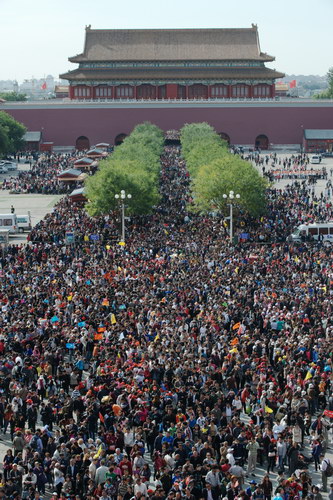Economy
Large crowds force Forbidden City to rethink ticketing policy
By Shan Juan (China Daily)
Updated: 2010-10-07 09:57
 |
Large Medium Small |
Beijing - Overwhelmed by a huge number of visitors who flocked to the capital's Forbidden City during the National Day holiday, authorities at the 590-year-old palace said an e-ticketing system will be introduced next year to cap entries in a bid to protect the monument.
 |
|
Thousands of tourists wait at the entrance of the Forbidden City in Beijing on Oct 3, 2010. [Photo/China Daily] |
One of China's biggest tourist attractions, the Palace Museum, as it is also known, received far more visitors during the seven-day Golden Week holiday than its daily capacity of 60,000.
On Oct 2 alone, some 122,000 people entered through the gate of the Forbidden City, the Chinese imperial palace from the Ming Dynasty (1368-1644) to the end of the Qing Dynasty (1644-1911).
Currently, all tickets to the walled enclosure, located in central Beijing, are sold manually, which fails to accurately monitor the flow of visitors.
"Once the e-ticketing system is operational, the computer will stop selling tickets if the number of visitors has reached the museum's maximum capacity," Feng Nai'en, the museum's assistant director, told China Daily on Oct 5.
He said such a move is the need of the hour not only to protect the monument but also to ensure a better experience for the visitors.
The museum has already suffered as a result of excessive visits, according to Feng.
"The floor is worn down. The color of the signature vermeil walls has faded due to exposure to great amounts of carbon dioxide exhaled by visitors," he said.
Luo Zhewen, an expert in ancient architecture, said large number of visitors is a common challenge facing the protection of historical heritages in the country.
"To preserve our monuments, we must put a cap on the number of visitors," he was quoted as saying in the Beijing News.
Besides, with fewer people around, visitors will be able to enjoy their time at such sites even more, said Jiang Yan, a division director of the capital tourism bureau.
According to local media reports, people had to wait at least an hour and a half to get a ticket to the Forbidden City during the National Day holiday.
"Inside was no better," said a visitor surnamed Pan. "It was impossible to enter the toilets as hundreds of people were waiting in line."
|
||||
"For most people like me, it is a rare opportunity to come to Beijing and see the Palace Museum," he said.
Wei Xiao'an, who heads the academic committee at the China Travel Research Academy, said: "The tourist's right to visit the Forbidden City should be respected without bringing harm to the monument."
Wei suggested the introduction of a reservation system, which will not only control the number of visitors but also help authorities plan in advance for busy days.
In 2009, Southwest China's Tibet autonomous region passed a regulation to protect the Potala Palace, the former imperial palace in Tibet, and put a limit of 2,300 on the number of visitors per day.



